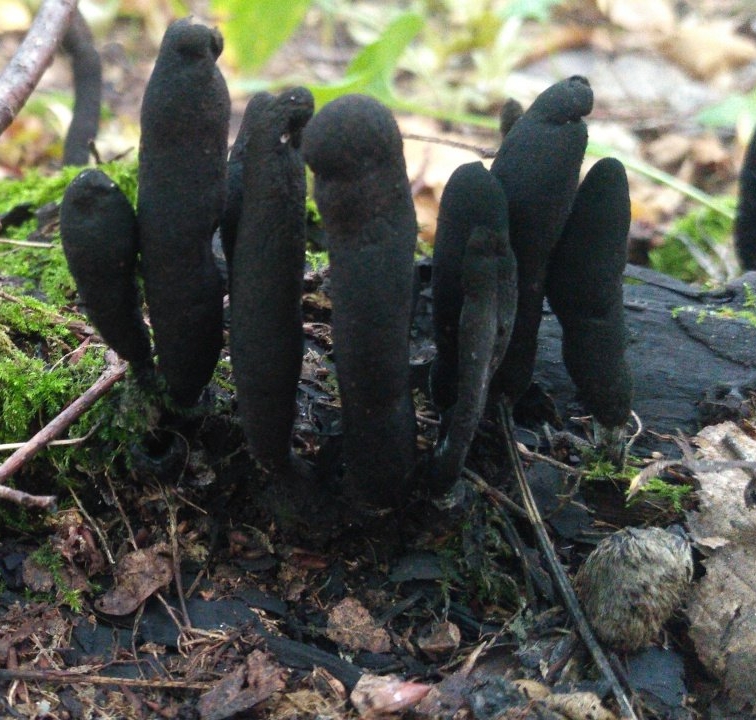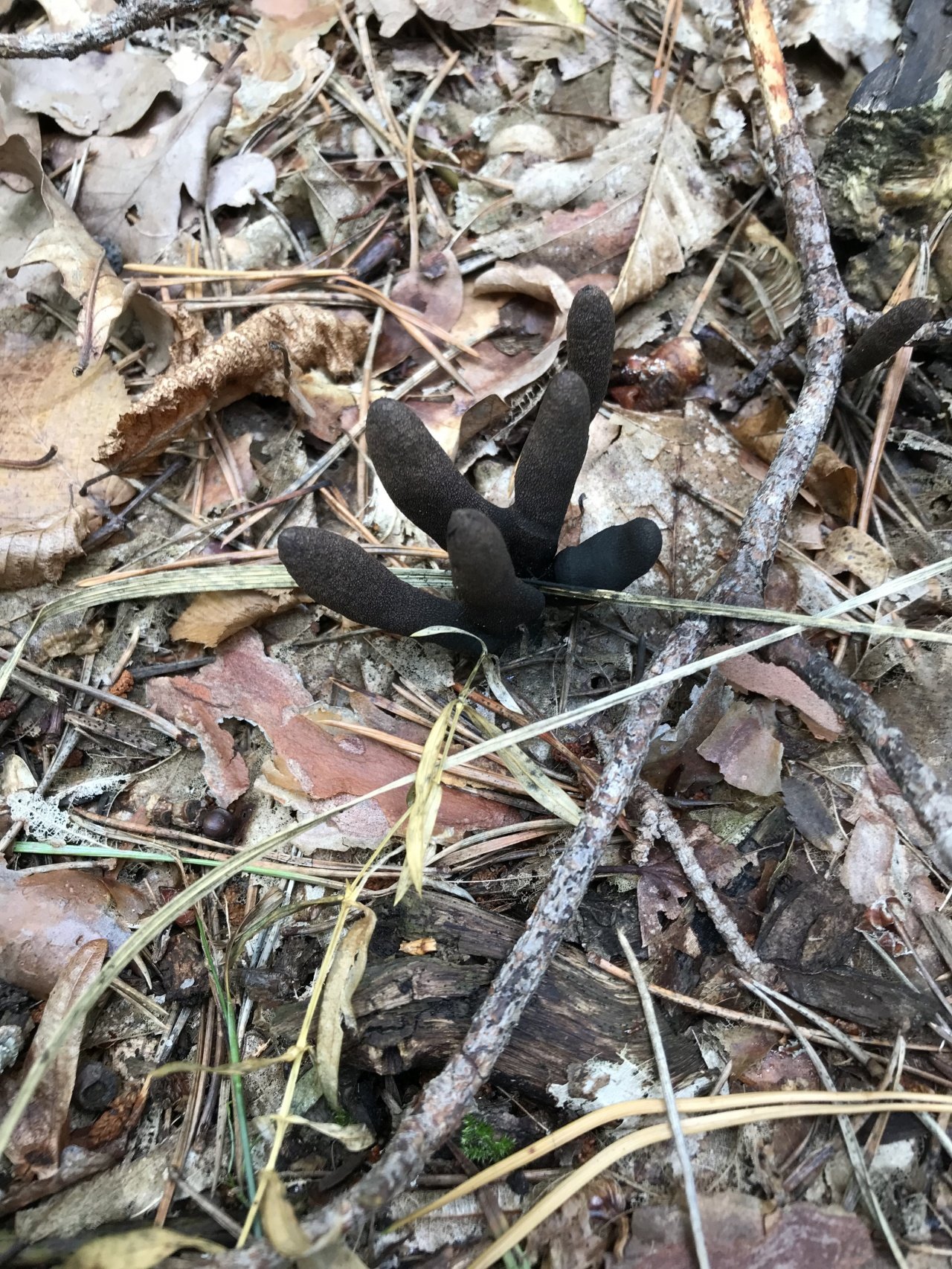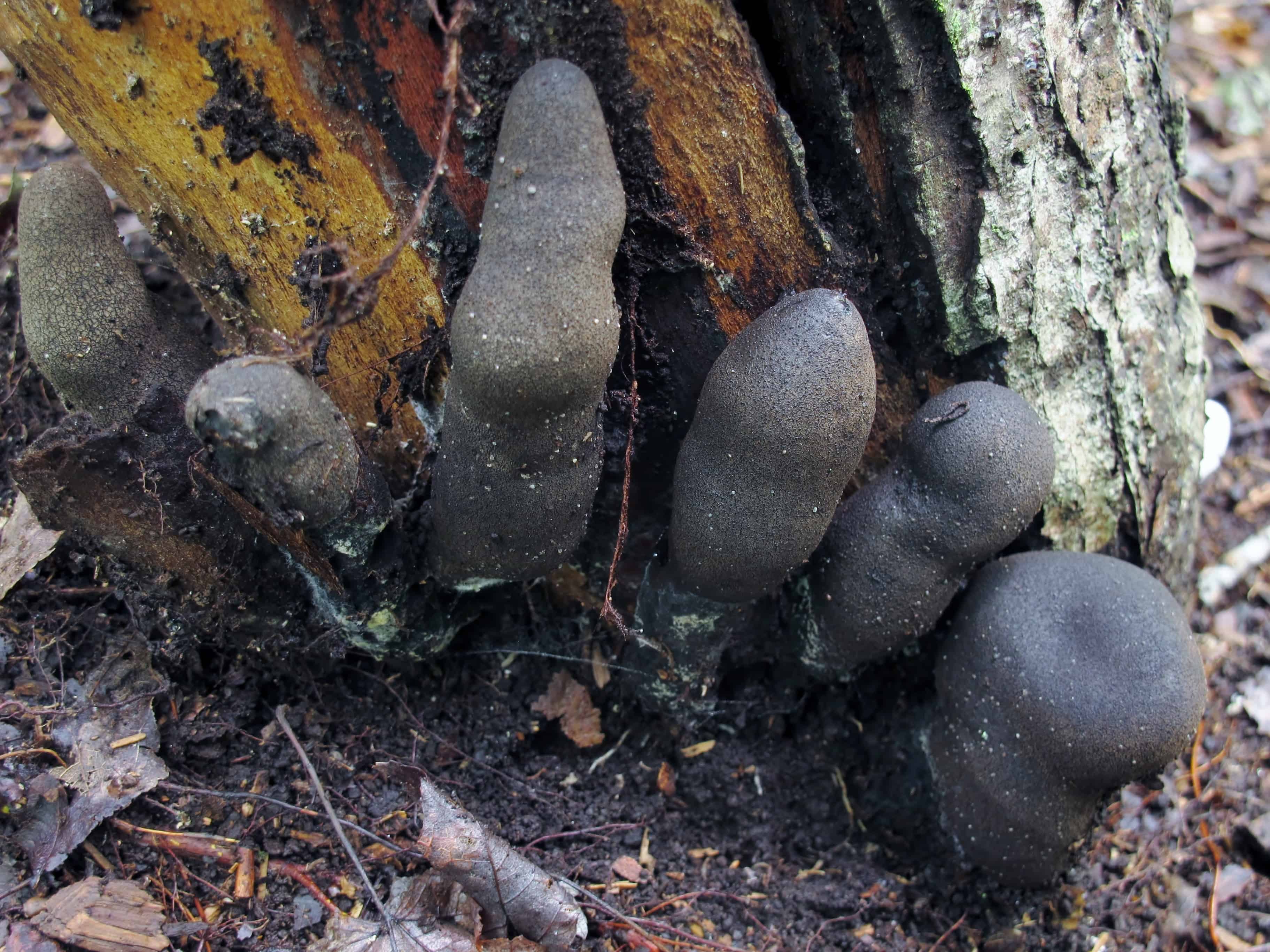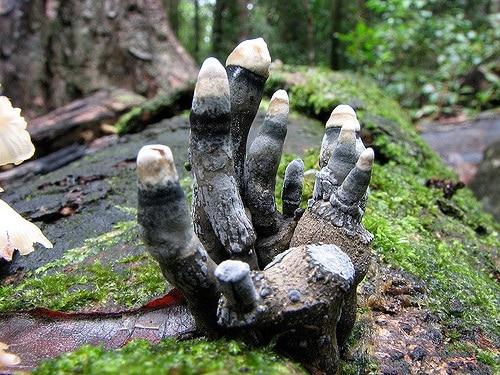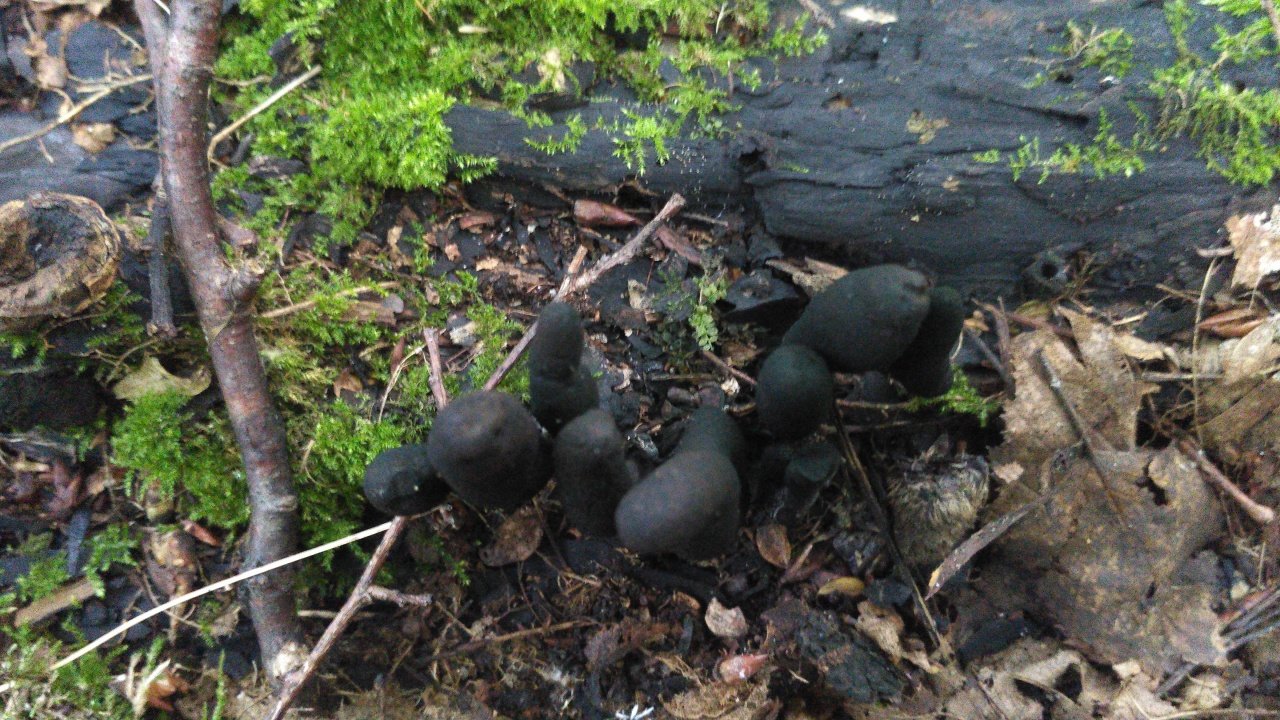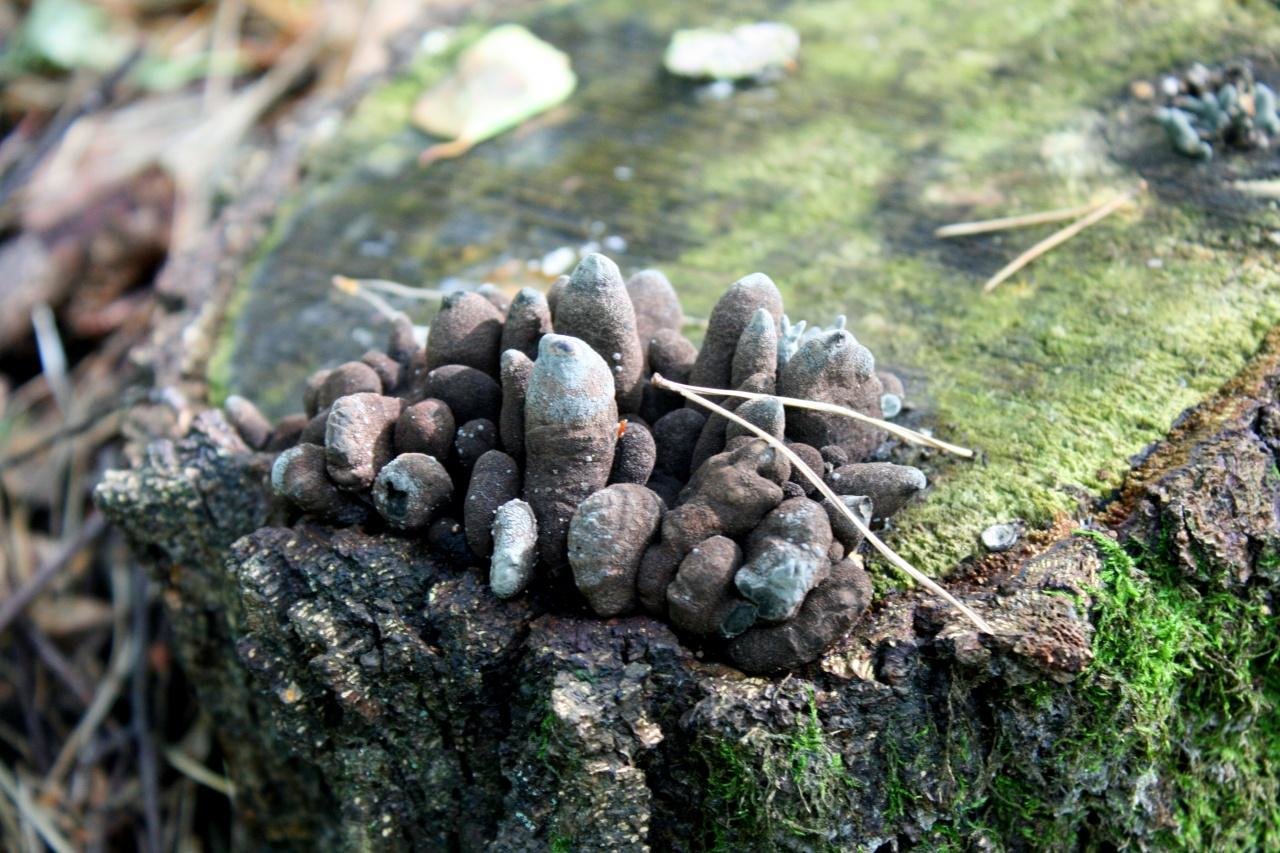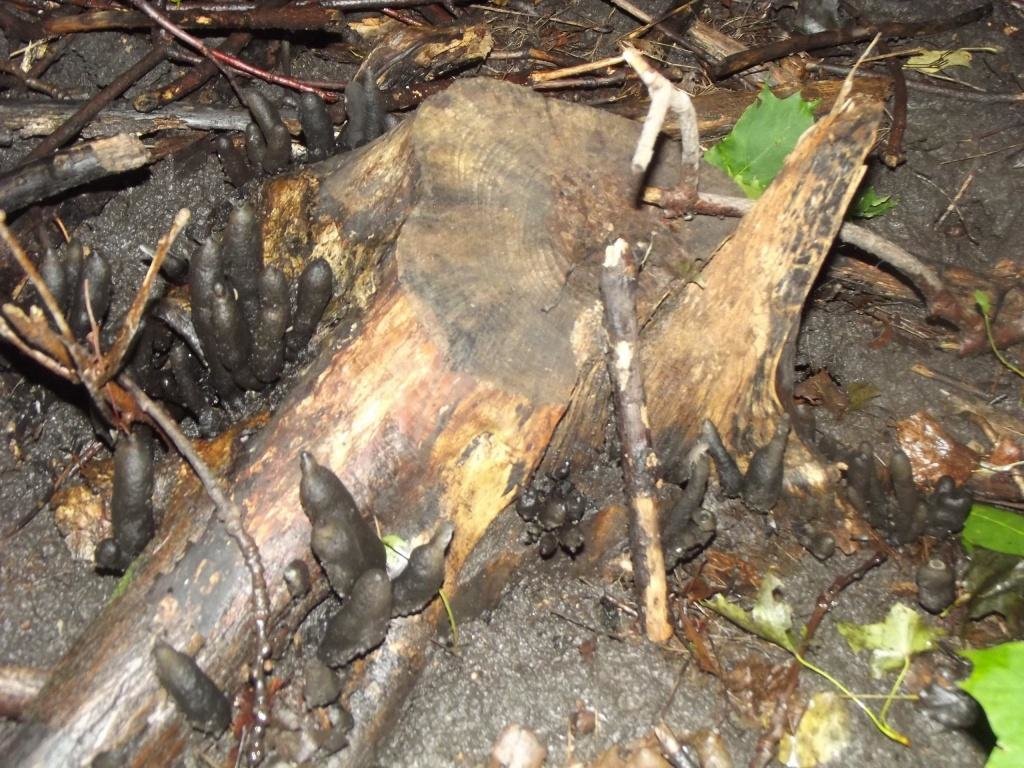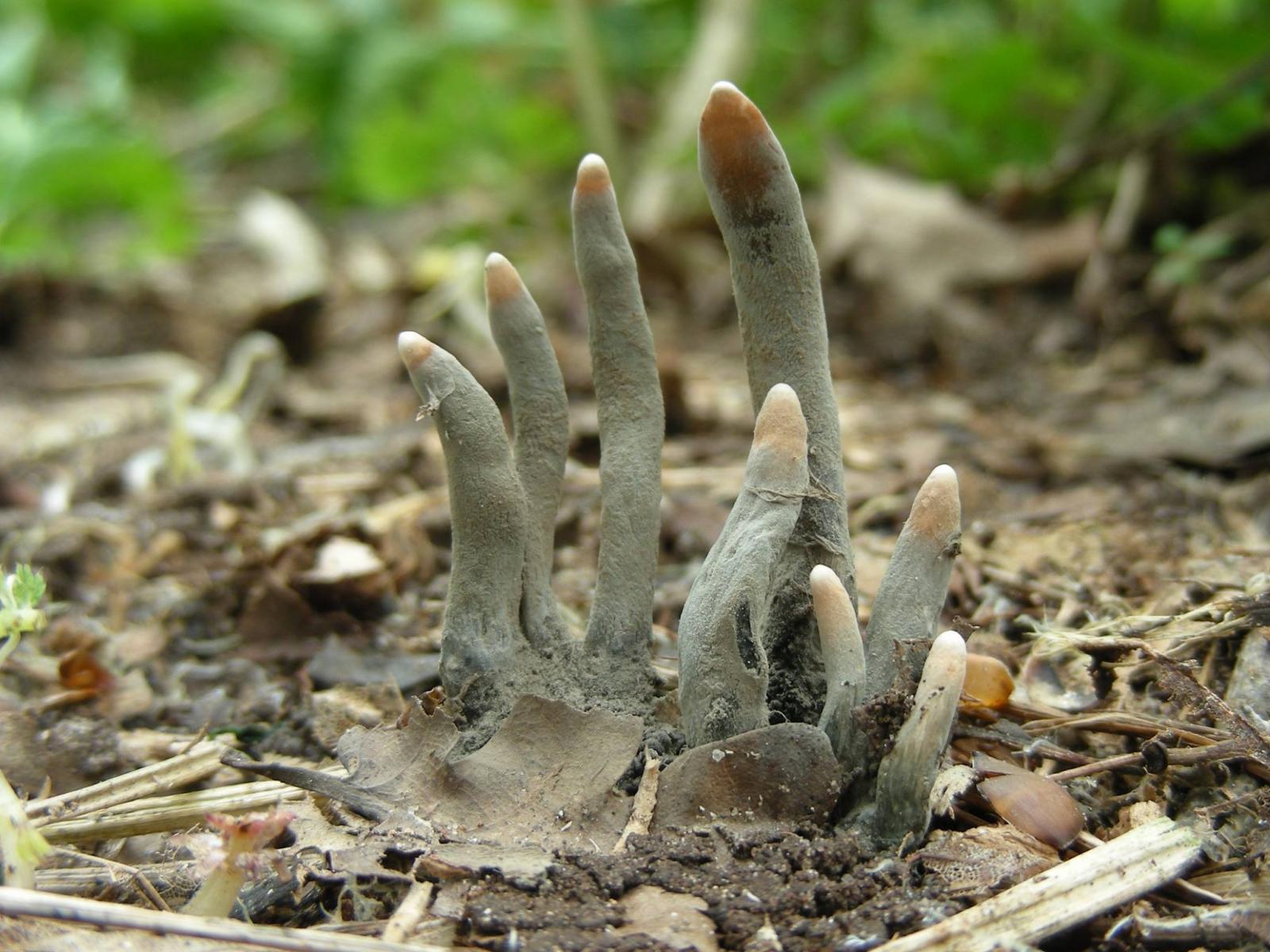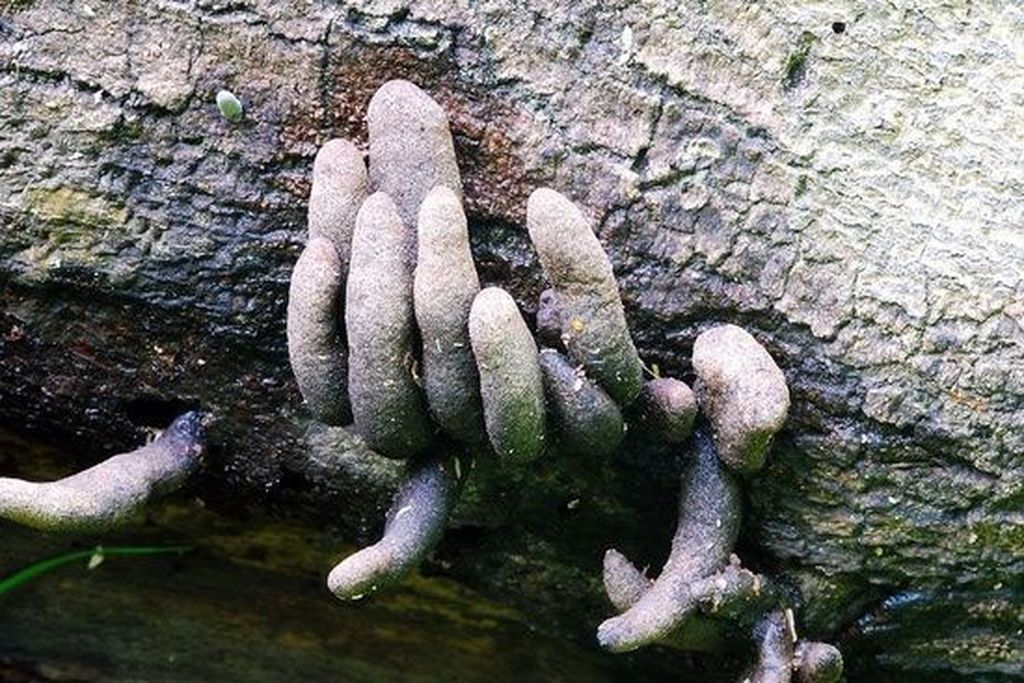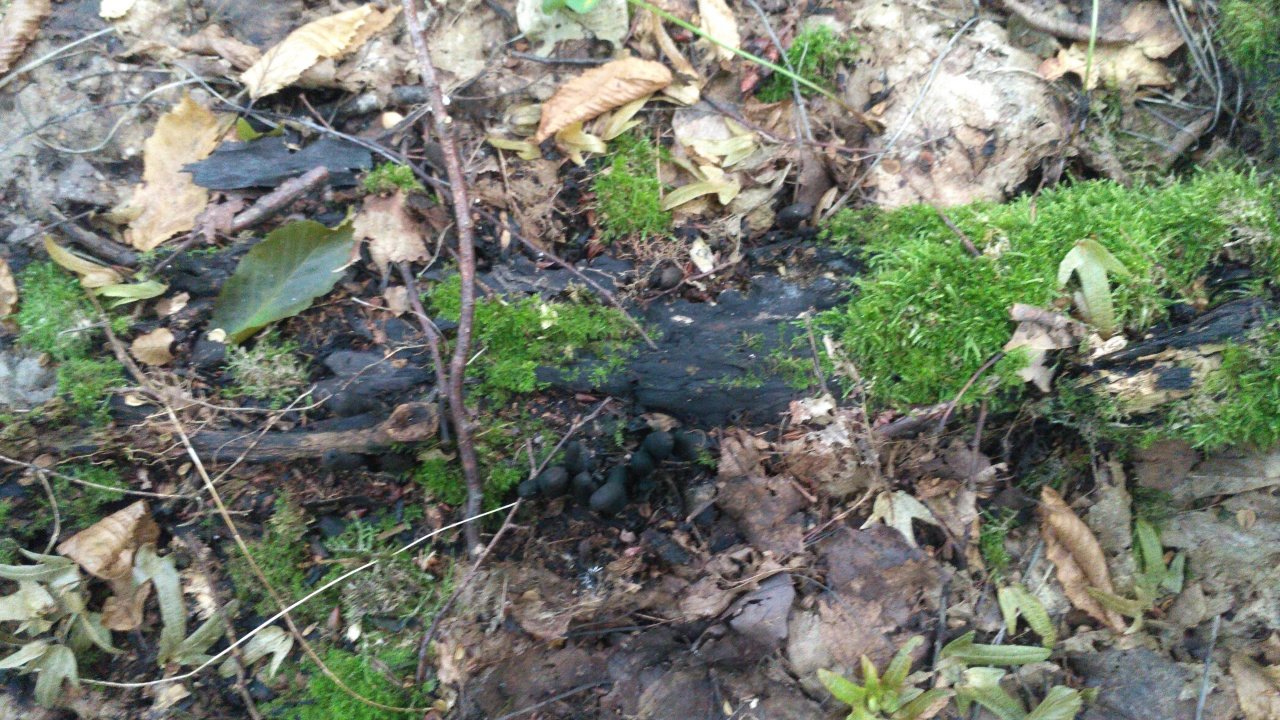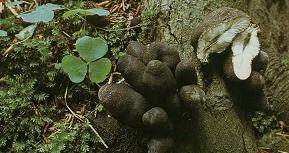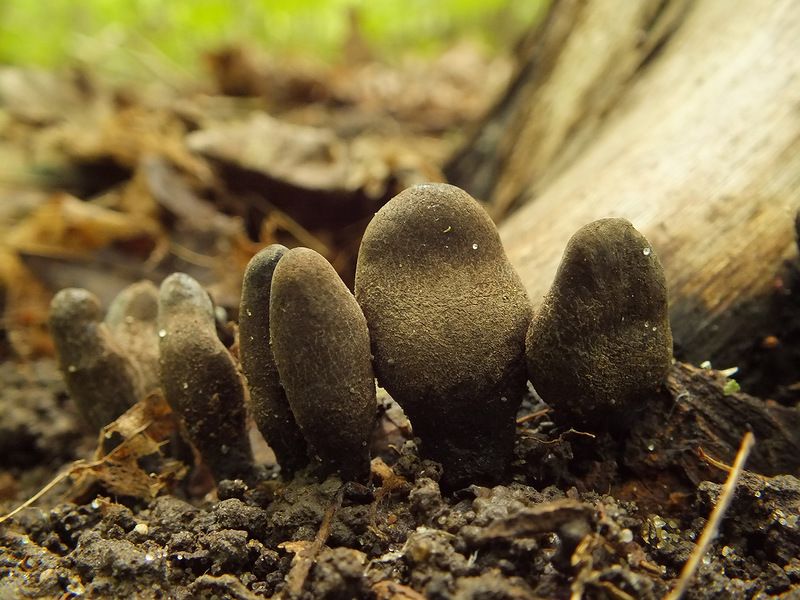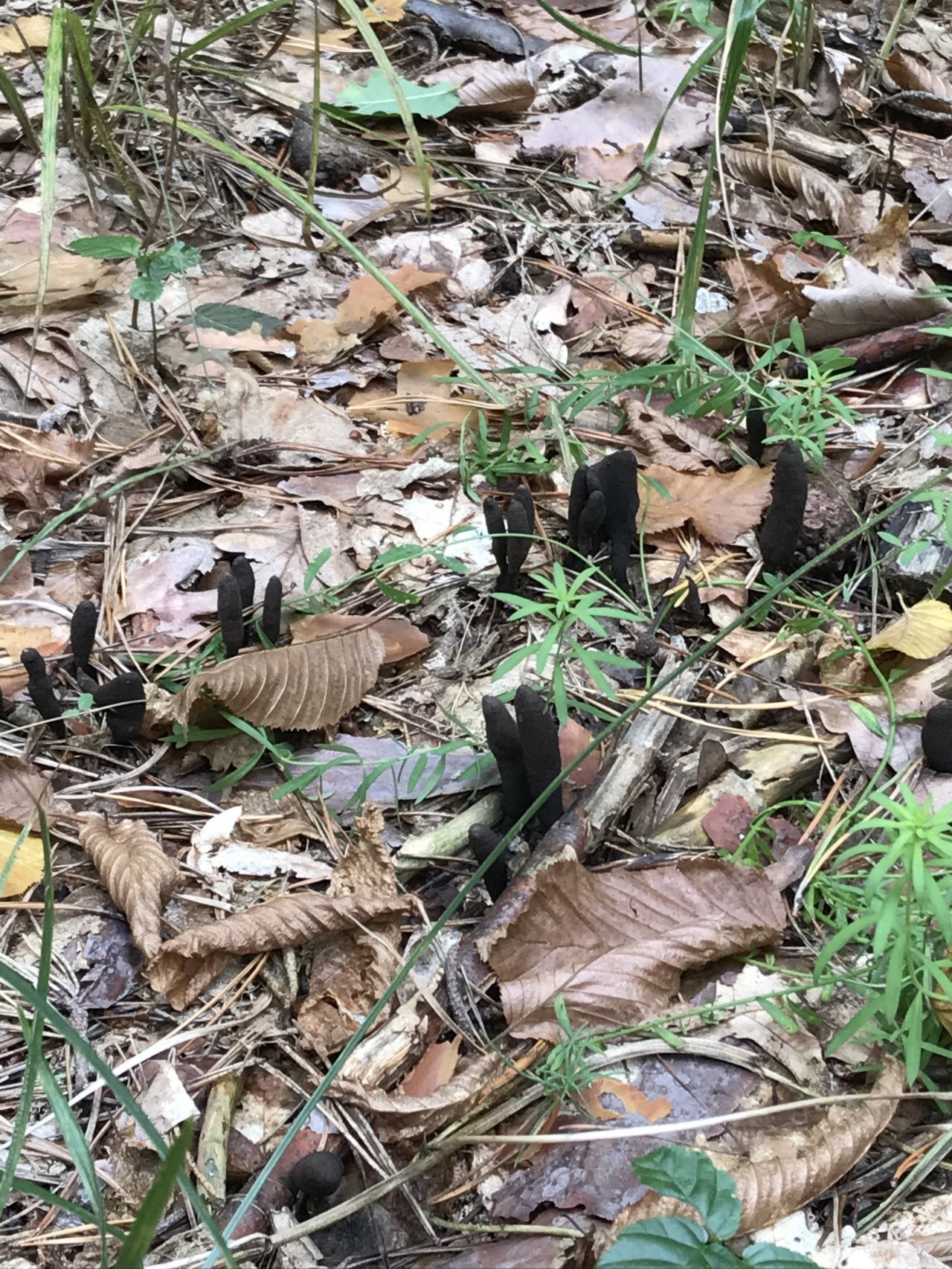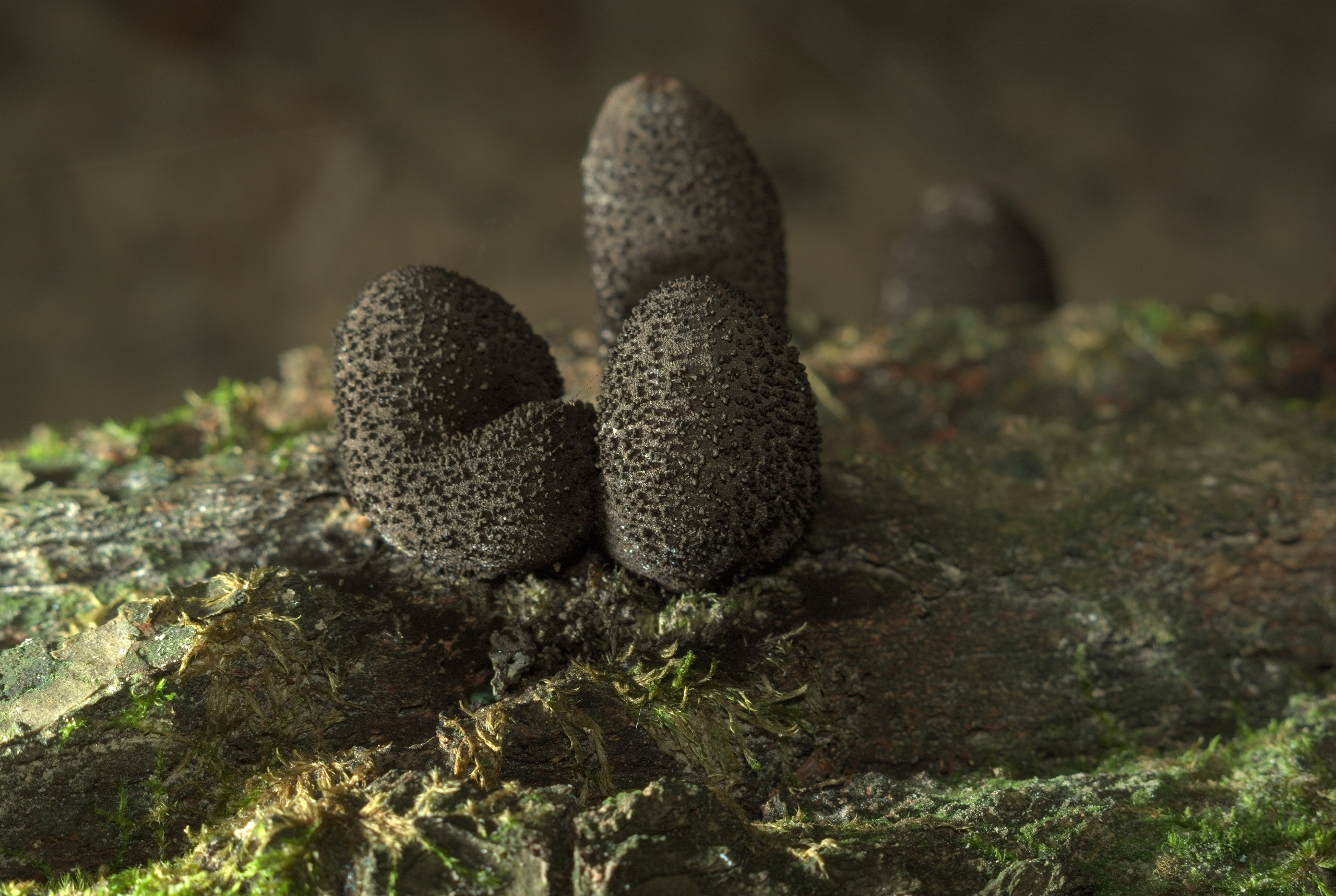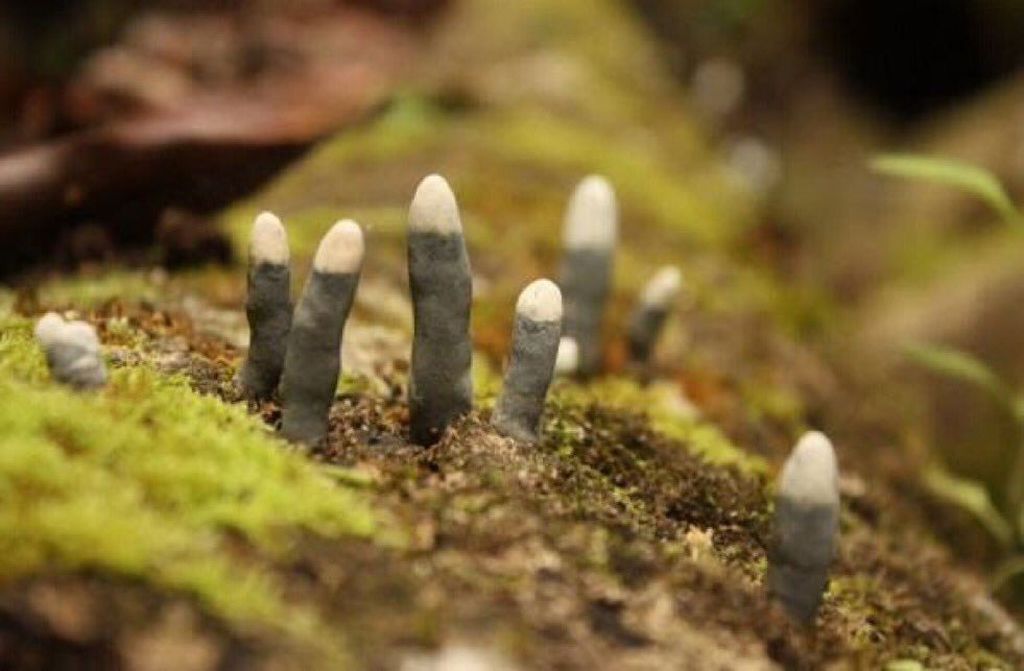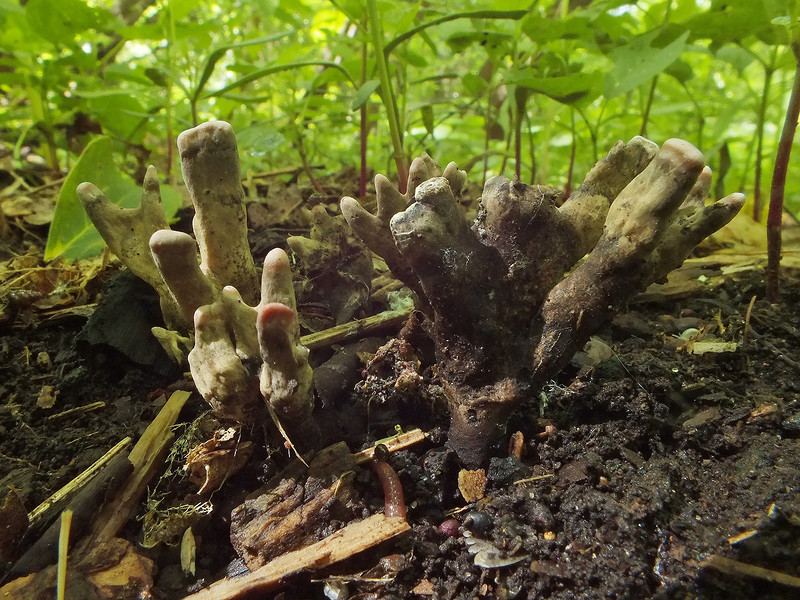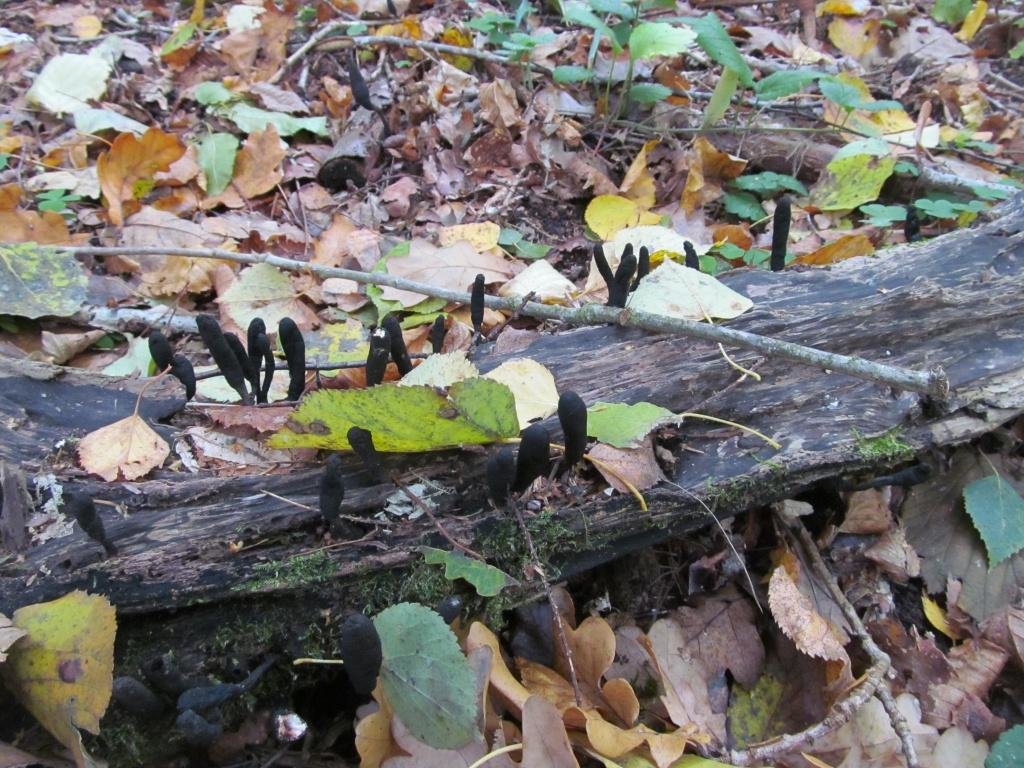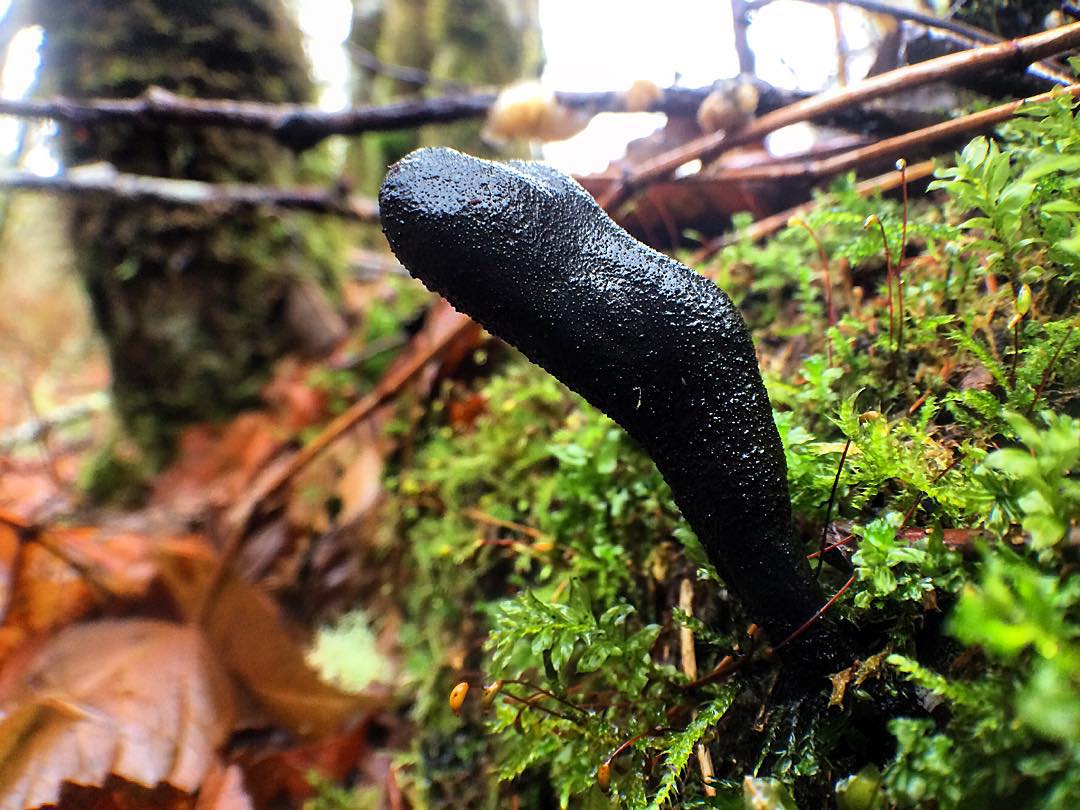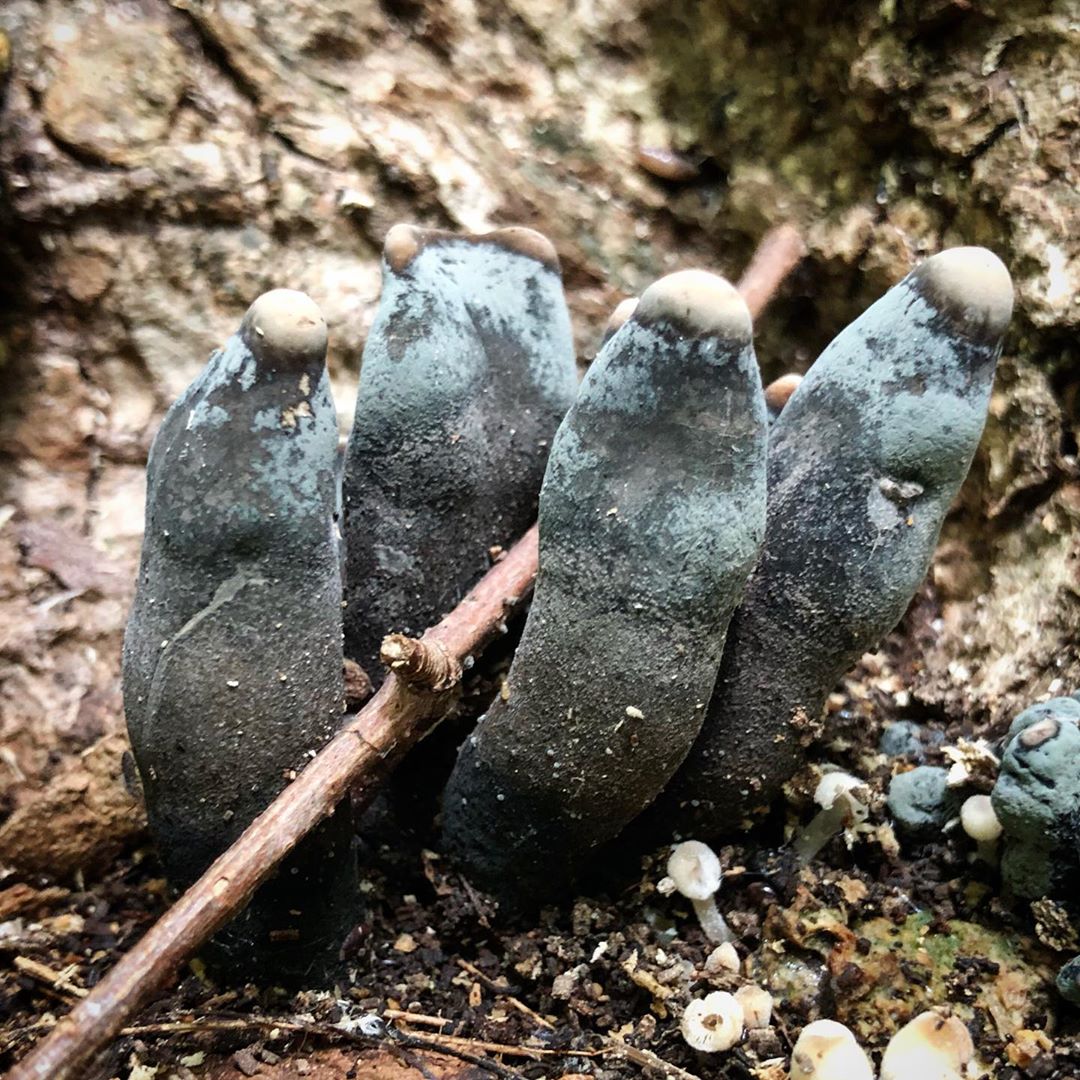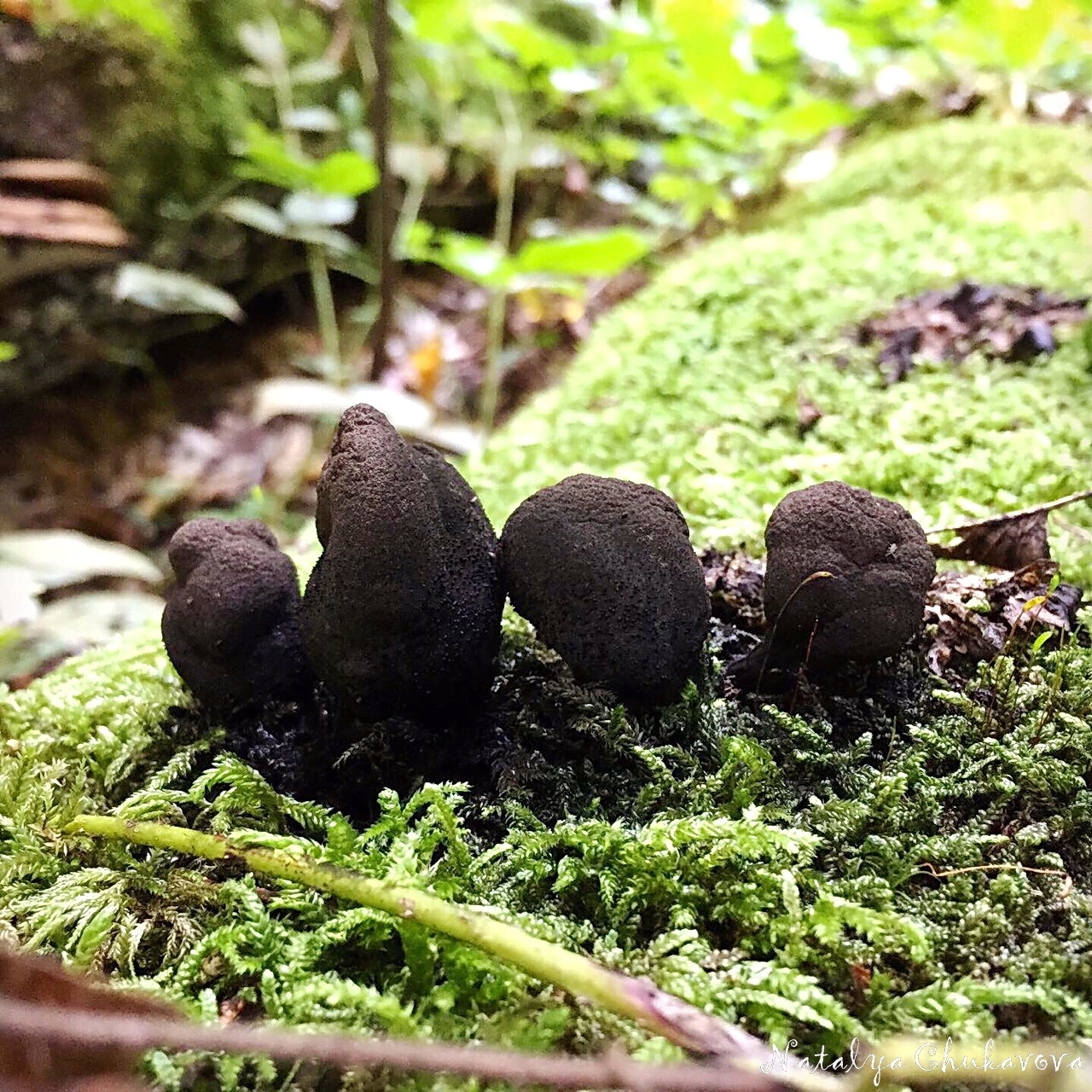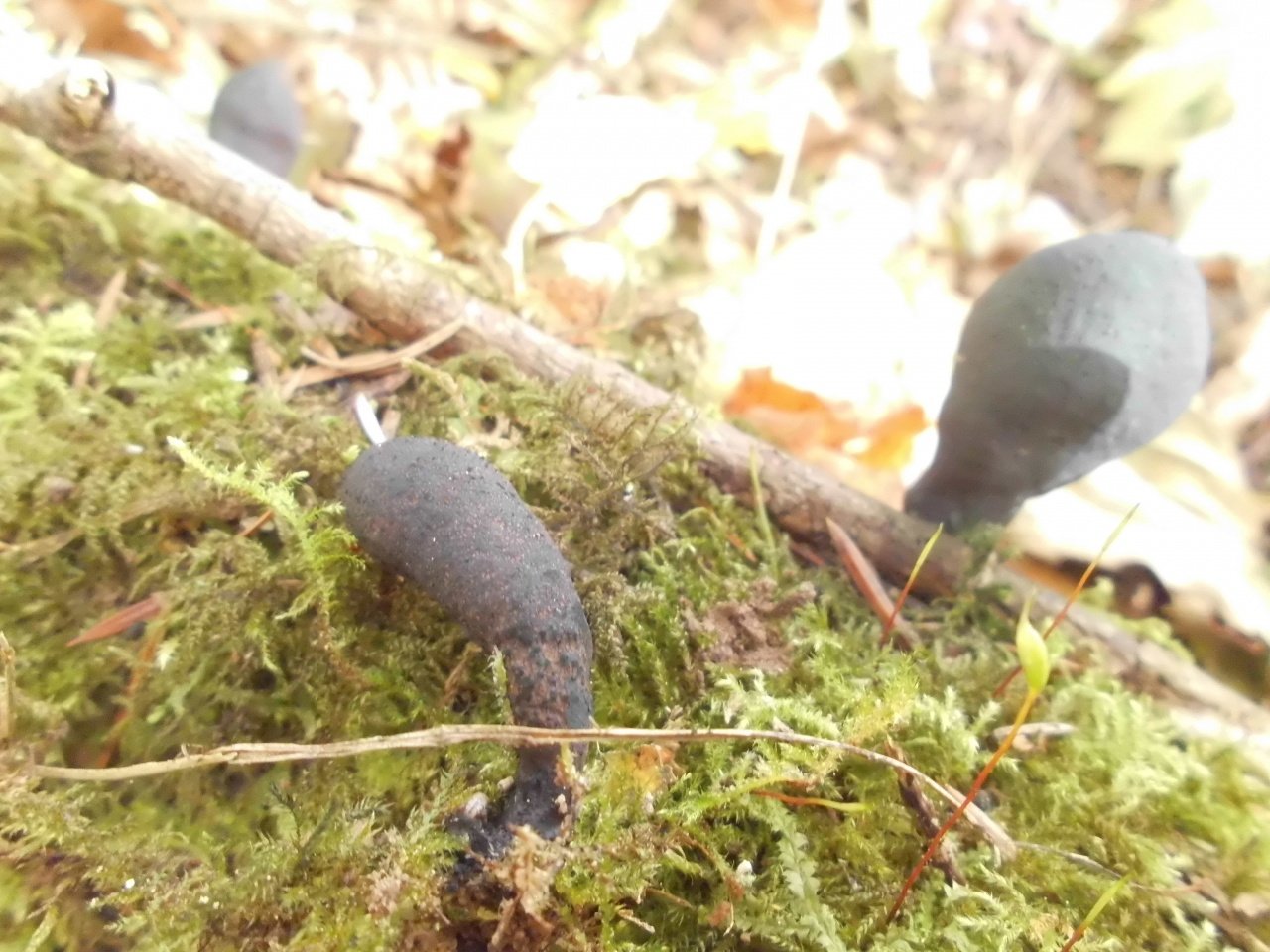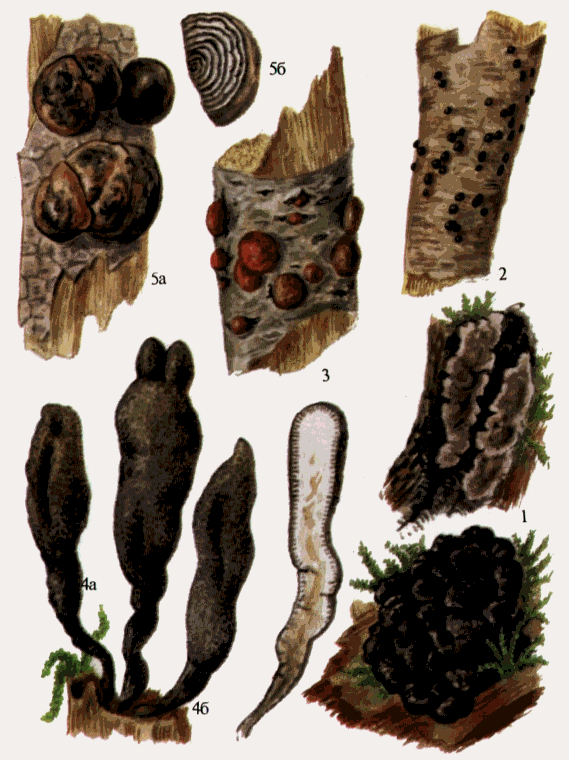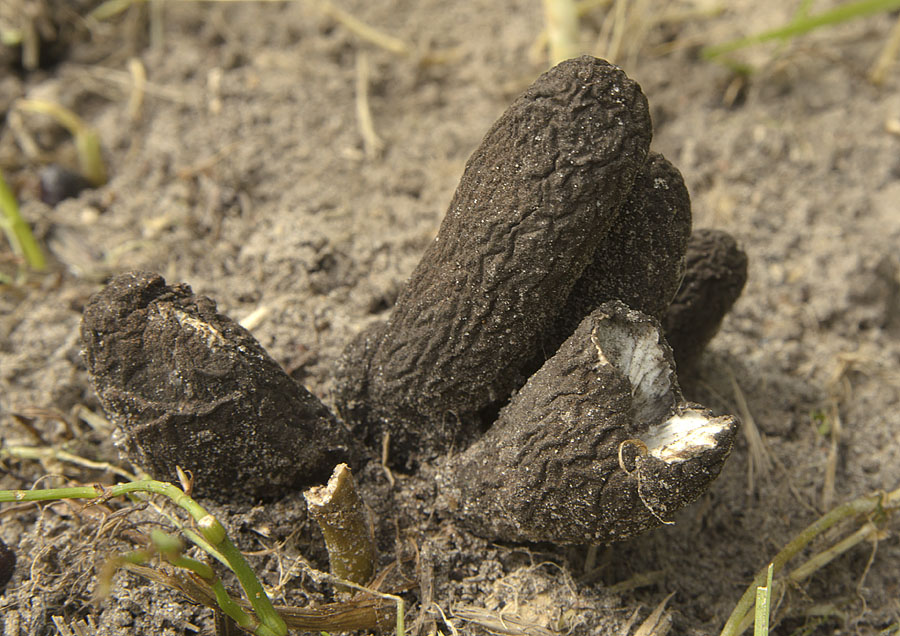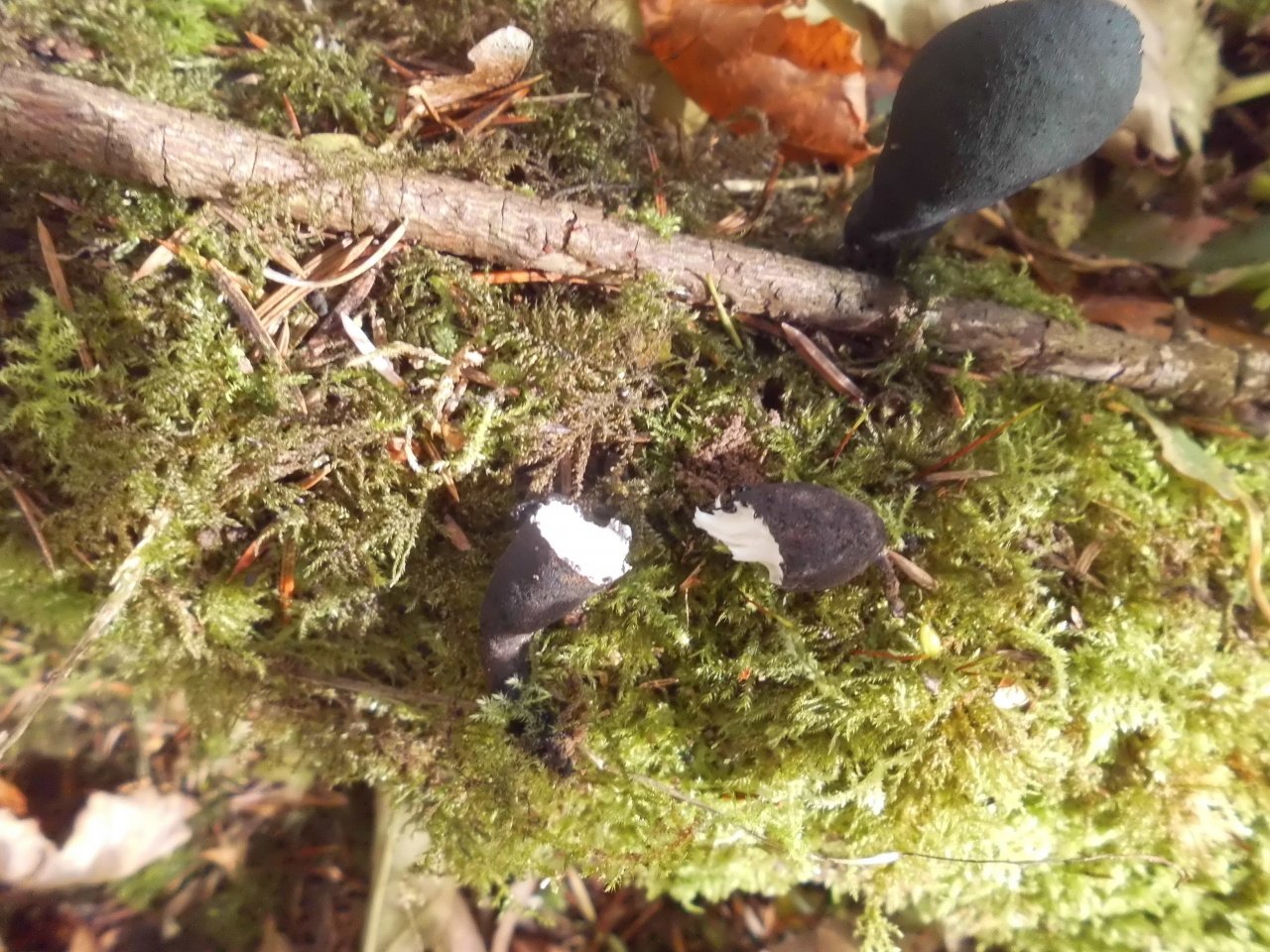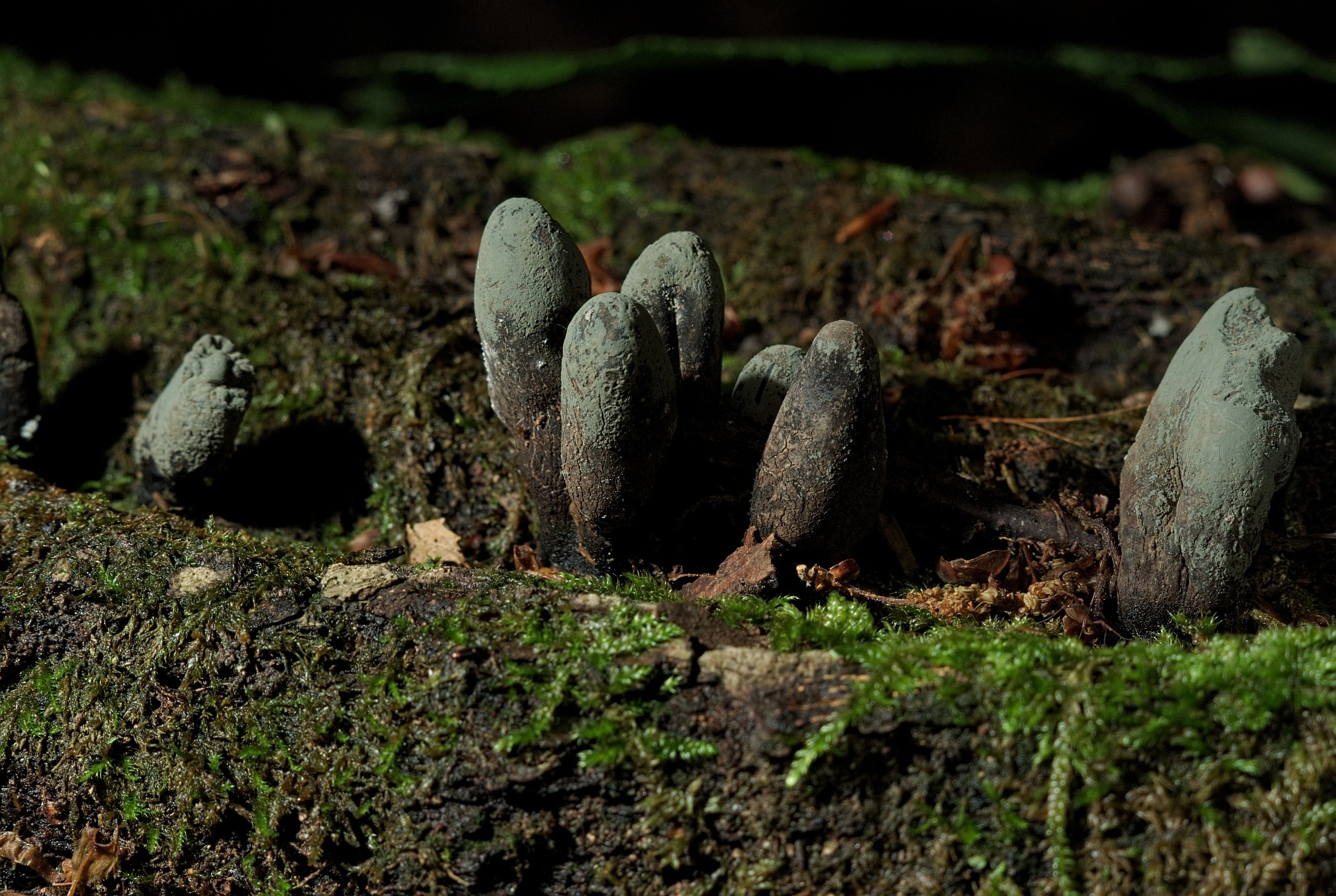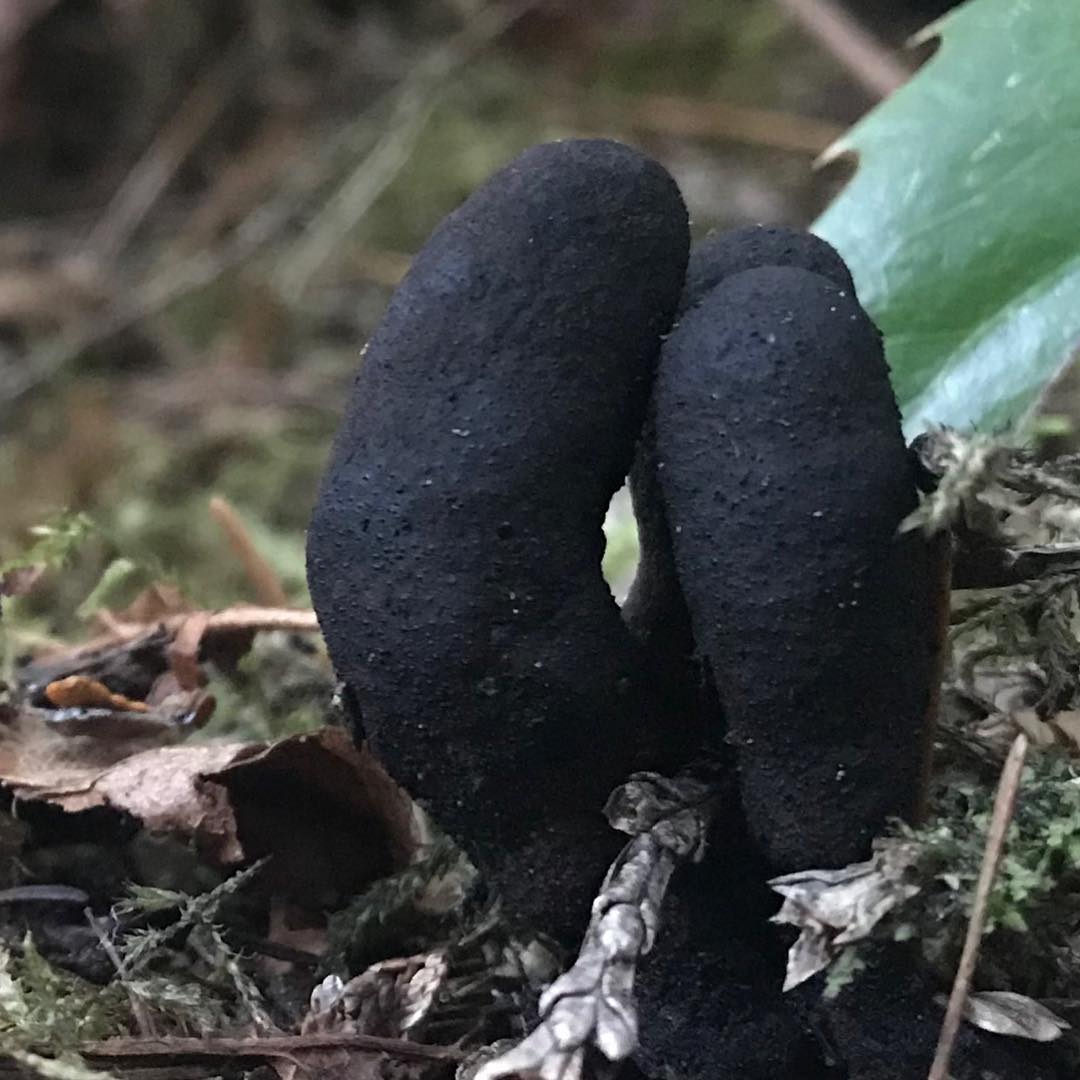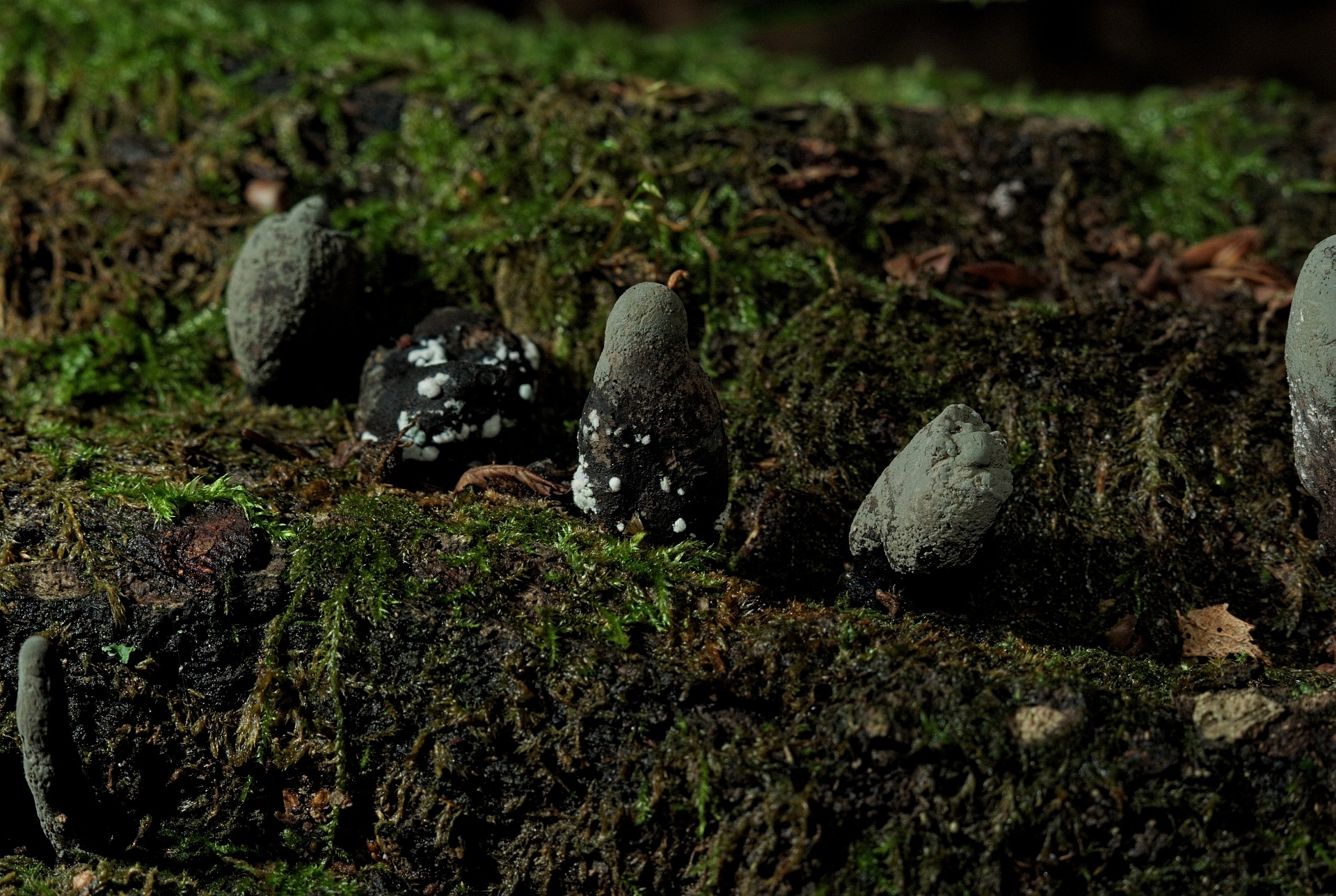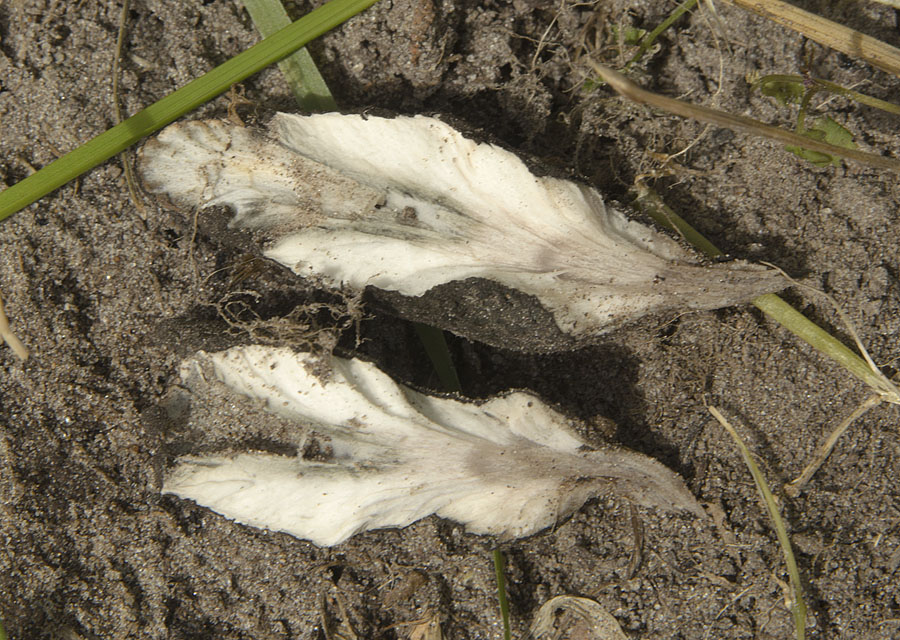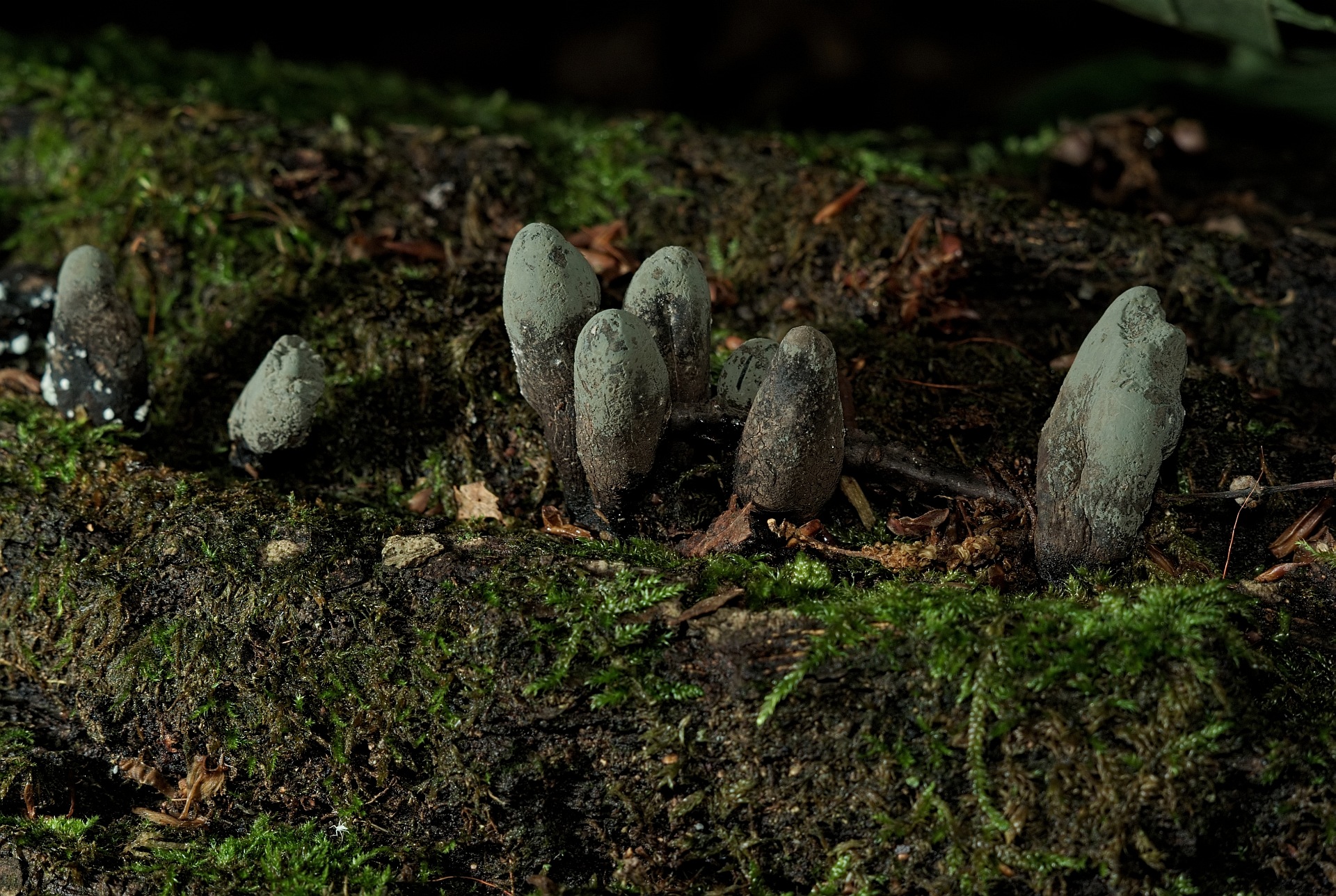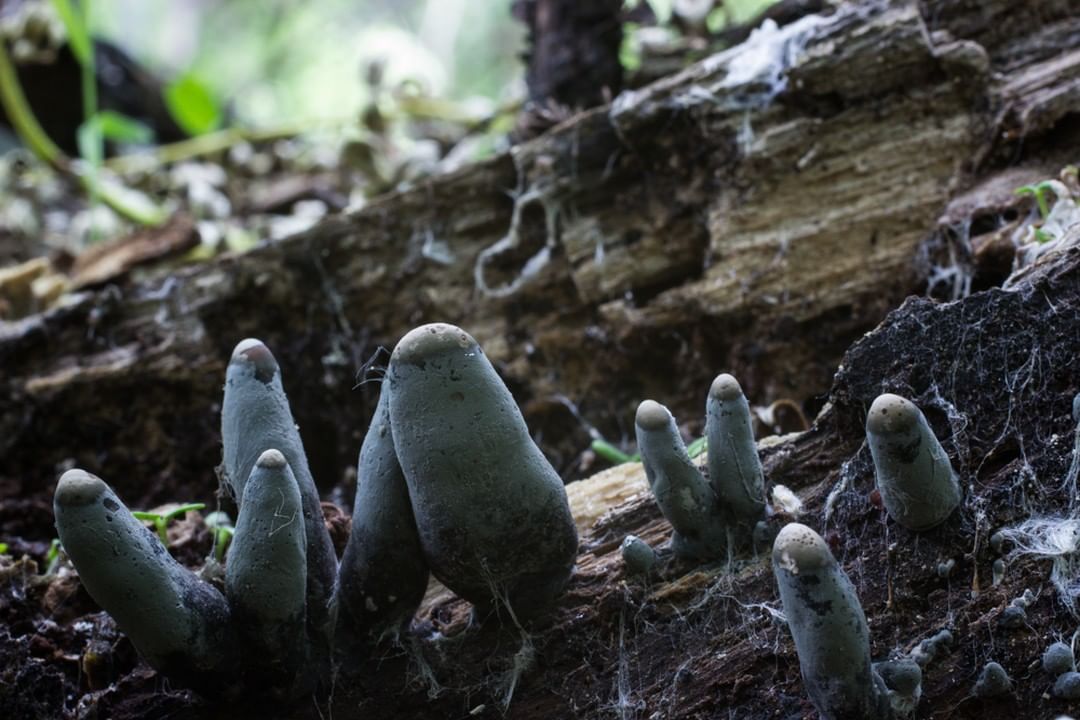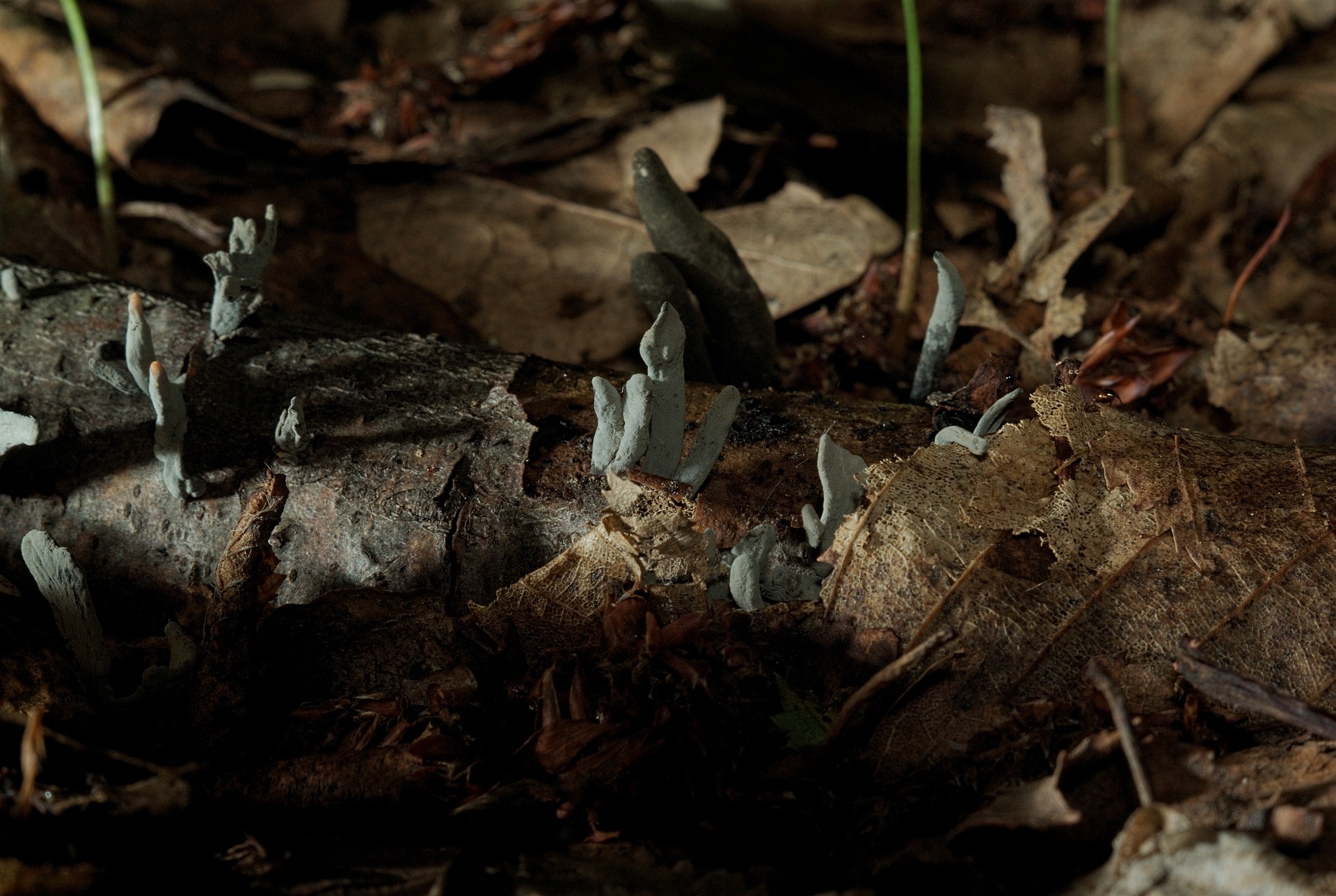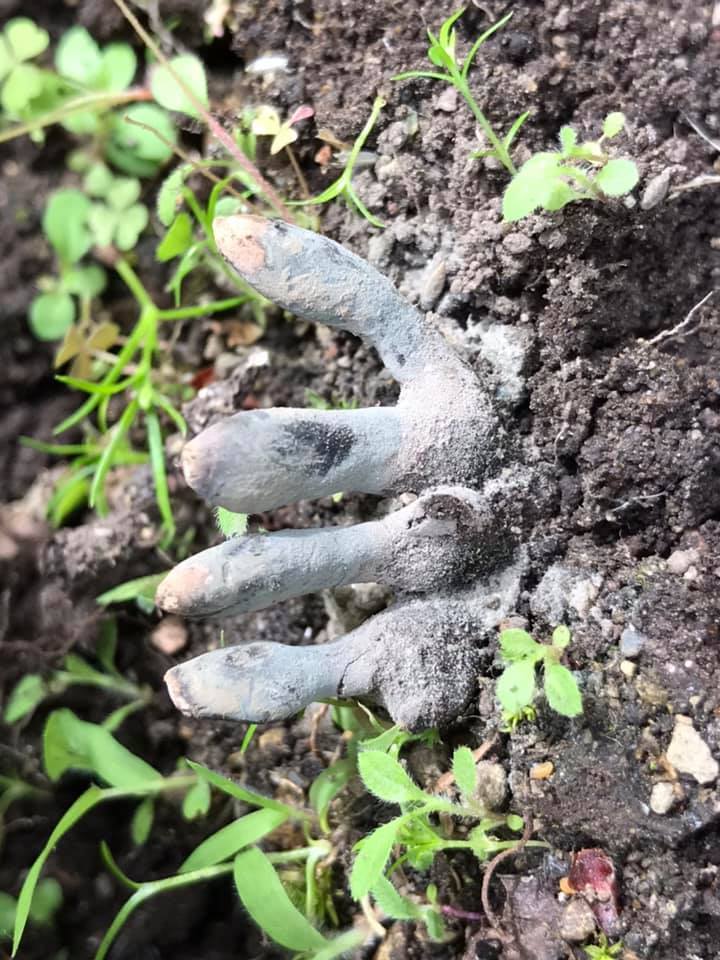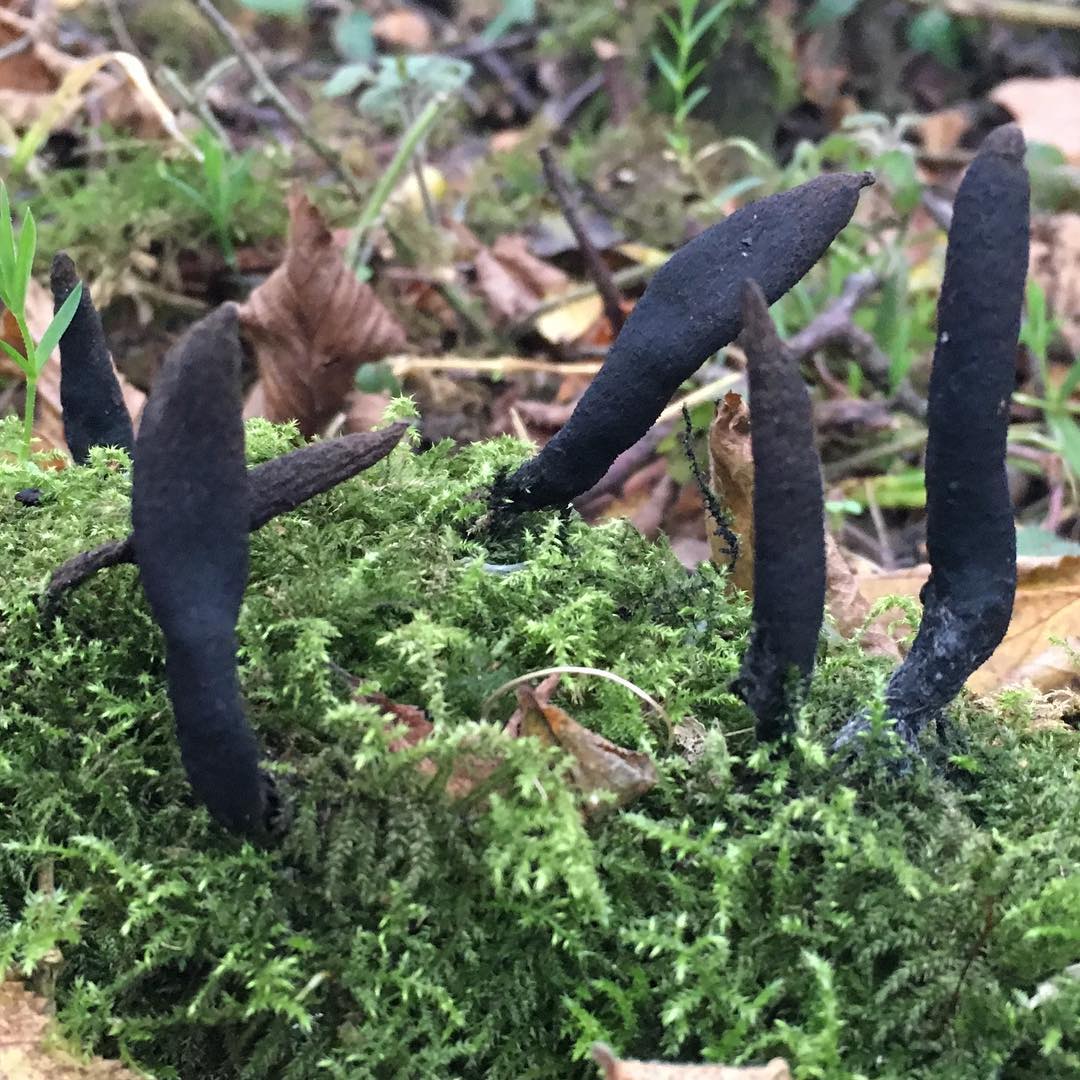Xylaria multiforme (Xylaria polymorpha)
Dead man's fingers
This strange mushroom, often called "Dead Man's Fingers", can be found from spring to late autumn, as it develops very slowly. Young - pale, bluish, often with a whitish tip. Its pale outer cover is asexual spores, conidia, appearing at an early stage of development. By summer, however, the mushroom begins to turn black, and by the end of summer or fall, it is completely black and dried out. Somewhere in the middle of this transformation process, Xilaria multifaceted really looks like "dead man's fingers" eerily sticking out of the ground. However, in the final stages, most likely, it looks like a "present" left by a domestic cat.
Xylaria polymorpha is the most common of the larger Xylaria species, but the species name, Dead Man's Fingers, is often used broadly to encompass several species that are microscopically differentiated.
Description
Ecology: saprophyte on decaying deciduous stumps and logs, as a rule, at the base of a tree or very close, but sometimes it can grow as if from the ground - in fact, there are always buried remains of wood there, in the ground. It can grow singly, but is more common in clusters. Causes soft wood rot.
Fruit body: 3-10 cm in height and up to 2.5 cm in diameter. Hard, dense. More or less like a club or a finger, but sometimes flattened, it can be branched. Usually with a rounded tip. In youth it is covered with a pale bluish, gray-bluish, or purple dust of conidia (asexual spores), with the exception of the whitish tip, but as it matures it becomes blackish with a pale tip and eventually completely black, absolutely. The surface becomes thinly dried and wrinkled, a hole forms in the upper part through which ripe spores are thrown out.
Flesh: white, whitish, very tough.
Microscopic characteristics: spores 20-31 x 5-10 µm smooth, fusiform; with straight embryonic fissures extending from 1/2 to 2/3 of the spore length.
Season and distribution
Widespread throughout the planet. Usually it grows in groups, prefers to live on rotten wood and stumps of deciduous trees, favors oaks, beeches, elms, can grow on conifers. Sometimes found on the trunks of weakened and damaged living trees. From spring to frost, ripe fruit bodies do not disintegrate for a long time.
Other information about the mushroom
Possesses medicinal properties. In folk medicine in some countries it is used as a diuretic and as a drug to increase lactation.
Mushroom photo Diverse xilaria
from questions in recognition:
In nature, there are mushrooms that look like the hand of a dead person. For example - Xilaria multifaceted, also known as dead man's fingers. But let's not meet her “by her clothes”. In fact, the fruiting body has a medicinal effect, it contains useful substances.
Xylaria multiforme / Xylaria polymorpha
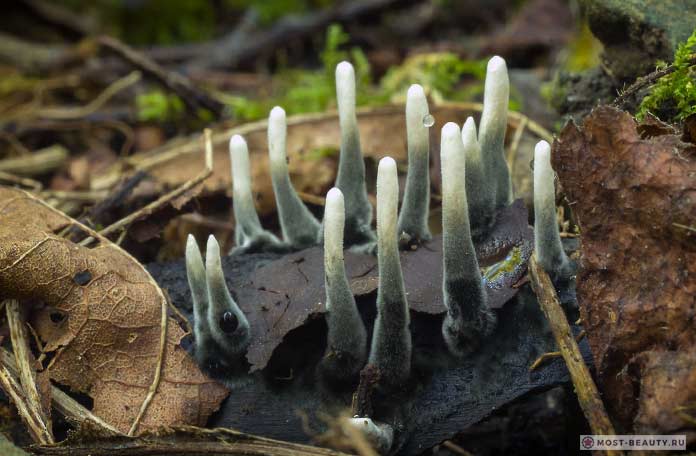
Despite such an unusual name "Dead Man's Fingers", which in ancient times was assigned to Xylaria polymorpha, people did not attribute any witchcraft or magical properties to the mushrooms.
Indeed, growing out of the ground, they resemble fingers in their shape and white color. The man did not begin to experience its properties on himself, but limited himself to simply describing the original species.
They love to grow in small groups, frightening those who like to walk through the forest even more.
16
Long-legged xilaria
Xylosphaera longipes
Long-legged Xilaria in English-speaking countries is called "dead moll's fingers" - "Fingers of a dead street girl", "Fingers of a dead prostitute."Creepy name, but it is the essence of the difference between long-legged Xilaria and Diverse Xilaria, which is called "Dead man's fingers": long-legged is thinner than diversified, and it often has a thin leg. The second popular name for Xilaria long-legged, in French, is pénis de bois mort, "a dead wooden penis."
Description
Fruit body: 2-8 centimeters in height and up to 2 cm in diameter, club-shaped, with a rounded end. In youth from gray to brown, with age becomes completely black. The surface of the fruiting body, as the fungus matures, becomes scaly and cracked. The leg is proportional to the length, however, it may be short or completely absent.
Spores 13-15 x 5-7 μm, smooth, fusiform, with spiral germinal fissures.
Ecology
Saprophyte on decaying deciduous logs, fallen trees, stumps and branches, especially loves beech and maple fragments. They grow singly and in groups, in forests, sometimes at forest edges. Causes soft rot.
Similar species
Diverse xylaria (Xylaria polymorpha) is somewhat larger and "thicker", but a microscope is needed to distinguish these species in controversial cases. While X. longipes spores are 12 to 16 by 5-7 micrometers (μm) in size, X. polymorpha spores measure from 20 to 32 by 5-9 μm.
Other information about the mushroom
Scientists have discovered the amazing ability of this and another species of fungus (physisporinus vitreus) to positively influence the quality of wood. In particular, Professor Francis Schwarz of the Swiss Federal Laboratory for Materials Science and Technology Empa has invented a method of wood processing that changes the acoustic properties of natural materials.
The discovery is based on the use of special mushrooms and is able to bring modern violins closer to the sound of the famous works of Antonio Stradivari (writes about this in Science Daily).
Evaluation of taste, medicinal properties, benefits and possible harm
Known in medicine, but not officially applied. When studying, scientists found diuretics in the composition of the fruiting body. And also, it was possible to extract from the fibers of the fungus a substance that resists the reproduction of cancer cells and the spread of HIV throughout the body. The most valuable substances are:
- mannitol;
- polysaccharides.
Curious! In the Vedas, there is a mention of this terrible mushroom. Cases are described when ancient women ate it, thereby increasing lactation after childbirth.
The fungus is not poisonous, despite its intimidating outer shell. It is not used in cooking because of its tough pulp. It is considered inedible because it has a bland taste. Young mushrooms have no smell. The old ones smell like rot.
Xilaria Hypoxilon: description and photo
| Name: | Xilaria Hypoxilon |
| Latin name: | Xylaria hypoxylon |
| Type of: | Inedible |
| Synonyms: | Xylosphaera hypoxylon, Clavaria hypoxylon, Sphaeria hypoxylon, Xylaria Hypoxylon |
| Systematics: |
|
There are mushrooms of rather unusual and bizarre shapes that resemble various objects. Xylaria Hypoxilon is a fruiting body belonging to the Xylariaceae family, Xylaria genus, Xylaria Hypoxylon species.
What do xilariae hypoxilon look like?
The shape of this ascocarp resembles deer antlers, and from a distance the mushrooms look like coral polyps. They consist of several cylinders emerging from under the rotten leaves in one heap. As they grow, the fruiting bodies flatten, curl and bend. The flesh of the body is firm and thin. They are black at the base, dark gray above. It is not for nothing that the British call it "soot on a candle." Old xilariae take on a charcoal color. The surface is velvety in the lower part, with short hairs.
The height of the Xilaria Hypoxilon reaches 8 cm. The width reaches 8 mm. These are marsupial mushrooms: gray or dull white ascospores are scattered all over the body, similar to buds or cones (perithecia). Under the microscope, cylindrical bags with a high stem can be distinguished. They have small holes from where mature spores are released.
Where do xilariae hypoxilon grow
These mushrooms grow in deciduous, less often coniferous forests on rotten foliage or old stumps. On the territory of our country, they can be seen in the northern part.
But they are common not only in the northern hemisphere: they are also found in Cuba, and even in Australia. Sometimes mushroom pickers come across small groups of "deer antlers". But this is not common: these are rare species of Xylaria. They ripen in the fall before the onset of winter. But they persist for a long time: even in spring, their dried and blackened bodies protrude from under the snow.
Is it possible to eat hypoxilone xilariae
The Xiliaria hypoxilon mushroom is considered inedible due to its small size, lack of a pleasant mushroom taste, and dry pulp. There is no information about the toxicity of these ascocarps.
Healing properties
Mushrooms can be used for the production of medicines, as their extracts have the following properties:
- They have hemagglutinating effects, which makes it possible to use them for the diagnosis of various viral diseases.
- Their antiproliferative properties can inhibit the growth of cancer cells.
- They are able to stop the mutagenic effects of chemical radiation.
Conclusion
Xilaria Hypoxilon and its properties are not fully understood. Research on this fungus is ongoing. There are theories about the possibility of using its bioactive components for the treatment of cancer and immunodeficiency.
Long-legged xilaria what it looks like, where it grows, edibility, how to distinguish it, photo
Long-legged xilaria: description and photo
| Name: | Long-legged xilaria |
| Latin name: | Xylaria longipes |
| View: | Inedible |
| Synonyms: | Xylosphaera longipes, Xilaria long-legged, Xilaria long-legged |
| Systematics: |
|
The mushroom kingdom is diverse and amazing specimens can be found in it. Long-legged xilaria is an original and frightening mushroom, it is not without reason that people call it "dead man's fingers". But there is nothing mystical about it: the unusual elongated shape and dark color with bright ends resemble a human hand sticking out of the ground.
How long-legged xilariae look
The second name of this species is polymorphic. The body does not have an obvious division into a leg and a cap. In height it reaches 8 cm, but in most cases it grows small - up to 3 cm. In diameter it does not exceed 2 cm, the body is formed narrow and elongated.
It has a clavate shape with a slight thickening at the top; it can be mistaken for a tree twig. Young specimens are light gray, with age, the color darkens and turns completely black. Small outgrowths on the ground are hard to see.
Over time, the surface of the fruiting body also changes. It scales and cracks. The spores are small, fusiform.
Allocate the next type of xilaria - varied. It is distinguished by the fact that several processes, hard to the touch and rough, resembling wood, depart simultaneously from one fruiting body. In the middle, the pulp is made of fibers and is covered with white paint. It is quite tough, so it is not eaten.
The young fruiting body is covered with asexual spores of purple, gray or light blue color. Only the whitish ends remain free from spores.
The upper part of the fruiting body is slightly brighter in adulthood. Long-legged xilaria may become covered with warts for some time. Small holes appear in the cap for ejection of spores.
Where long-legged xilariae grow
Refers to saprophytes, therefore it grows on stumps, logs, rotten deciduous trees, twigs. Representatives of this species are even more fond of fragments of maple and beech.
Long-legged xilariae grow in groups, but there are also single specimens. This type of fungus can cause gray rot in plants. In the domestic climate, it grows strongly from May to November. Occurs in forests, less often on forest edges.
The first descriptions of long-legged xilaria are found in the second half of the 1890s. Before that, there was a single mention of the fact that the parishioners of one English church in the cemetery revealed terrible mushrooms. They looked as if the fingers of the dead, black and coiled, were climbing out of the ground. Mushroom shoots were everywhere - on stumps, trees, the ground. A similar performance frightened people so much that they refused to enter the cemetery.
The churchyard was soon closed and abandoned. This view is easy to explain scientifically. Long-legged xilaria grows strongly on stumps, rotten and shabby wood. Can develop at the roots of deciduous trees. They are found all over the world. In some regions, the first long-legged xilariae appear early in the spring.
Is it possible to have long-legged xilariae
Long-legged xilaria is an inedible species. Even after prolonged cooking, the flesh is very tough and difficult to chew.
Mushrooms of this type do not stand out with any taste or smell. During cooking, they lure insects - this should be taken into account if there is a strong desire to conduct an experiment.
In classical medicine, a substance is isolated from the xilaria, which is used to create diuretics. Scientists are planning to use these fruiting bodies for the development of drugs for oncology.
Conclusion
Long-legged xilaria stands out with its original color and shape. At dusk, mushroom shoots can be mistaken for tree branches or gnarled fingers. This type is not toxic, but it is not used in food. In nature, these representatives of the mushroom kingdom perform a special function: they accelerate the decomposition of trees and stumps.

